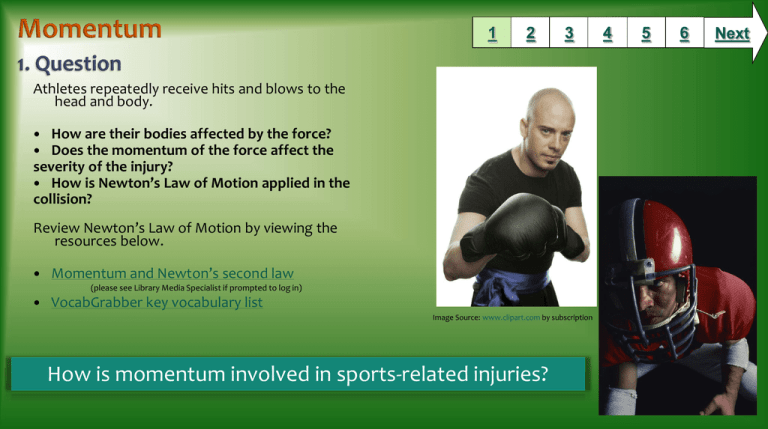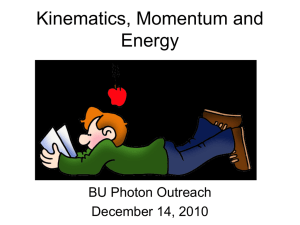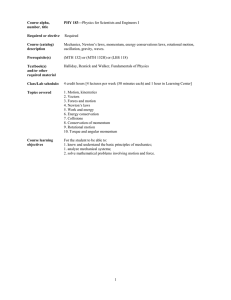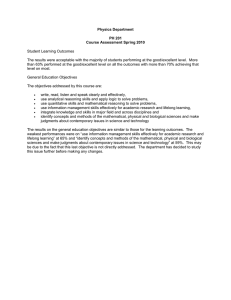
1
2
3
Athletes repeatedly receive hits and blows to the
head and body.
How are their bodies affected by the force?
Does the momentum of the force affect the
severity of the injury?
How is Newton’s Law of Motion applied in the
collision?
Review Newton’s Law of Motion by viewing the
resources below.
Momentum and Newton’s second law
(please see Library Media Specialist if prompted to log in)
VocabGrabber key vocabulary list
Image Source: www.clipart.com by subscription
How is momentum involved in sports-related injuries?
4
5
6
Next
1
2
3
4
5
6
Football and Boxing are two sports in which athletes receive
frequent blows to the body and head. The resources listed
below focus on the science behind the sports and injuries. Pay
close attention to:
causes of injuries
momentum and impact on injuries
Newton’s Law of Motion
This information will be needed to answer the question,
How is momentum involved in sports-related injuries?
Digital resources:
Science of NFL Football: Newton’s Third Law of Motion
Football: Mass, Momentum, and Collision
How the Physics of Football Works
Momentum and Its Conservation- Boxing Punch
Penn State University Physics Behind Boxing
Face Punch
Directions and Research Organizer provided on the next slide.
Image Source: www.clipart.com by subscription
Next
1
2
3
4
5
Gather information from the resources
provided on the previous slide. Use the
Momentum Research Organizer to
gather and organize the information.
Color-code the information using the
following guidelines:
Causes of injuries- yellow
Impact level/ momentum- green
Newton’s Law of Motion- purple
Save or print the Momentum Research
Organizer. Collaborate with a partner, as
directed by your teacher, to double check
the information gathered and to discuss
the correlation between momentum and
sports-related injuries.
Image Source: www.clipart.com by subscription
6
Next
1
2
3
4
5
After you have completed your Momentum Research Organizer, circle the information that
supports your answer to the essential question. You will need the information to form and
record your response in VoiceThread.
How is momentum involved in sports-related injuries?
Type your response below before recording. Support your answer
with information gathered from the provided resources.
Record (voice, type, or video) your response in the teachercreated VoiceThread. You will need to log-in first. Click on the
screenshot below to access the example VoiceThread.
6
Next
1
2
3
4
5
6
Create a poster or InfoGraphic identifying the
correlation between momentum and sportsrelated injuries. Focus the poster on informing
future athletic trainers about the science
behind sports-related injuries.
Resources to create a poster or InfoGraphic:
Create InfoGraphics online with Visaul.ly
Create a poster using Glogster or Microsoft
Publisher.
Image Source: www.clipart.com by subscription
Safari Montage- Athletic Trainers
Science Buddies-Science Careers: Athletic
Trainer
Next
1
BCPS Curriculum
KSI-B Evaluate real-world situations and/or laboratory investigations to identify the relationship between
weight and mass.
KSI-C Apply Newton's Laws to analyze real world examples.
Maryland State Curriculum
5.1 The student will know and apply the laws of mechanics to explain the behavior of the physical world.
Common Core State Standards
Reading: 1. Read closely to determine what the text says explicitly and to make logical inferences from it; cite
specific textual evidence when writing or speaking to support conclusions drawn from the text.
Writing: 7. Conduct short as well as more sustained research projects based on focused questions,
demonstrating understanding of the subject under investigation.
RST.9-10.5 Analyze the structure of the relationships among concepts in a text, including relationships among
key terms (e.g., force, frictions, reaction force, energy).
WHST.9-10.7 - Conduct short as well as more sustained research projects to answer a question (including a selfgenerated question) or solve a problem; narrow or broaden the inquiry when appropriate; synthesize multiple
sources on the subject, demonstrating understanding of the subject under investigation.
Standards for the 21st Century Learner
1.1.6 Read, view, and listen for information presented in any format (e.g. textual, visual, media, digital) in order
to make inferences and gather meaning.
2.1.3 Use strategies to draw conclusions from information and apply knowledge to curricular areas, real-world
situations, and further investigations.
ISTE Student NETS
3. Research and Information Fluency Students apply digital tools to gather, evaluate, and use information.
4. Critical Thinking, Problem Solving, and Decision Making Students use critical thinking skills to plan and
conduct research, manage projects, solve problems, and make informed decisions using appropriate digital
tools and resources.
2
3
4
5
6
Time Frame:
1 90 minute class period in a computer lab
Differentiation:
Digital Resources are leveled as Silver Stars- Basic and Gold StarsChallenging
Students may read the transcript of the NBC Learn video
Students may utilize the read-aloud feature in GALE Science in
Context
Learning Styles:
Field Dependent, Field Independent, Global Understanding, Reflective,
Visual, Auditory
Notes to the teacher:
•
Collaborate with your school’s Library Media Specialist to
implement this Slam Dunk Lesson.
•
Direct students to SAVE and then OPEN this PowerPoint file and
view in Slide Show mode for interactivity.
•
Direct students to save or print the Momentum Research Organizer
after completing.
•
You will need to create the VoiceThread and create student
accounts in order to access and use VoiceThread. Please see your
Library Media Specialist or Technology Liaison for support.
•
If you want to use Glogster, you will need to register and set up
accounts. See your school’s Library Media Specialist or Technology
Liaison for assistance.
Last updated: July 2012
Created by Amanda Cochran , Library Media Specialist
BCPS Slam Dunk Research Model, Copyright 2012, Baltimore County Public Schools, MD, all rights reserved. The models may be used for educational, non-profit school use only.
All other uses, transmissions, and duplications are prohibited unless permission is granted expressly. This lesson is based on Jamie McKenzie’s Slam Dunk Lesson module.







